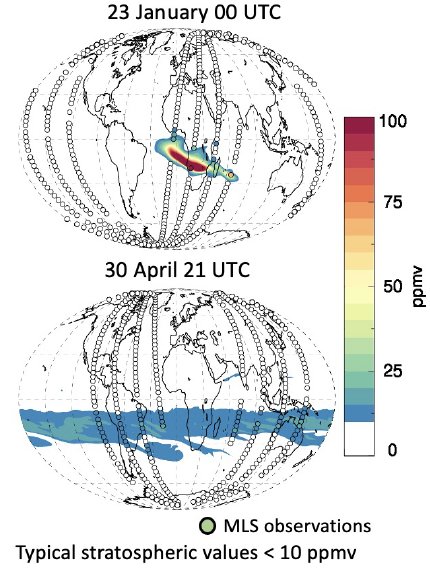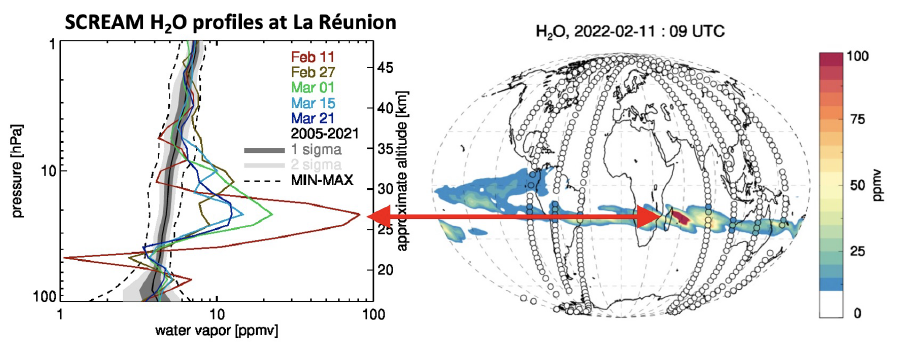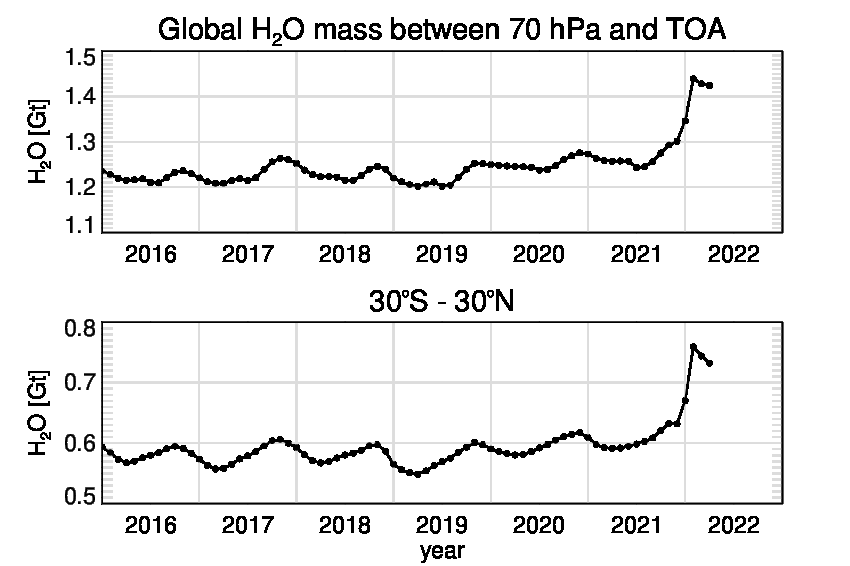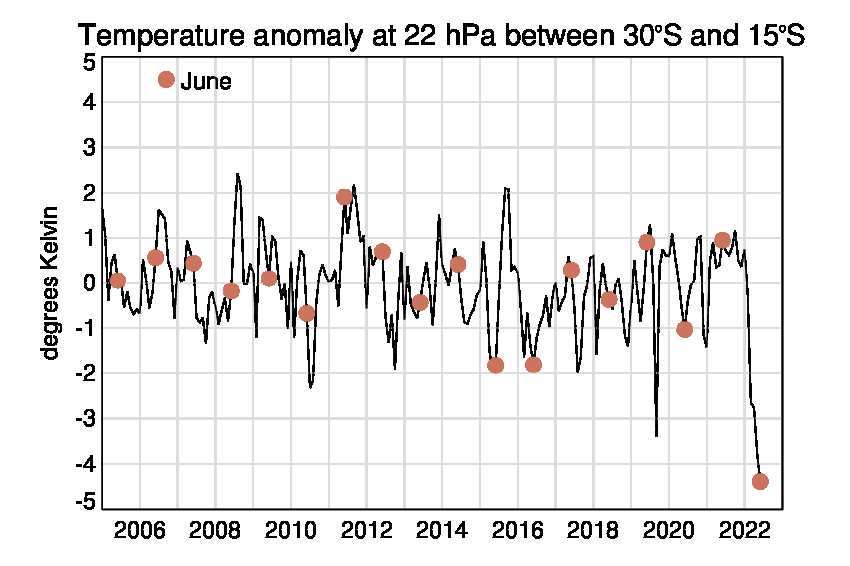Unprecedented Amount of Water Vapor Injected into the Stratosphere by the Hunga Tonga Eruption
The eruption of the submarine volcano, Hunga Tonga–Hunga Ha'apai (hereafter, Hunga Tonga), in the South Pacific on 15 January 2022 was one of the strongest volcanic events in recorded history. A very significant amount of material was instantly injected into the atmosphere, with the top of the plume reaching the lower mesosphere, much higher than observed during previous strong volcanic eruptions. Because this eruption occurred beneath the ocean surface, the plume was extremely rich in moisture (Millán et al. 2022). High water content is a unique characteristic of this event compared to other recent stratosphere-penetrating eruptions, such as that of Mt. Pinatubo in 1991. The amount of water vapor added to the middle atmosphere surpassed anything seen in the observational record so far. Compared to the troposphere, the stratosphere is very arid, with typical water vapor mixing ratios ranging between 3 and 7 parts per million by volume (ppmv). By comparison, preliminary estimates based on satellite and sonde data suggest that the maximum mixing ratio within the Hunga Tonga plume could have been as high as several hundred ppmv.
This preliminary study was done using the recently released composition reanalysis, M2-SCREAM (MERRA-2 Stratospheric Composition Reanalysis of Aura Microwave Limb Sounder), a stratosphere-focused chemical reanalysis developed at the GMAO (Wargan et al., 2022). M2-SCREAM assimilates ozone, water vapor, hydrogen chloride, nitric acid, and nitrous oxide observations from the Microwave Limb Sounder (MLS) instrument onboard NASA’s EOS Aura satellite between 2004 and present using the recently developed Constituent Data Assimilation System. This system configuration uses a version of the GEOS Atmospheric Global Circulation Model coupled with a stratospheric chemistry module, StratChem, and constrained by assimilated meteorology from the MERRA-2 reanalysis.
Fig. 1 shows water vapor mixing ratio from M2-SCREAM at the 650-K potential temperature surface (approximately 26 km) on two dates, one several days and one 3.5 months after the eruption.

An animation covering the entire period between 15 January and 30 April is shown below. The plume, which initially contained patches of water vapor maxima higher than 100 ppmv, traveled westward while becoming gradually stretched and partly dispersed, eventually filling the latitude band between 30°S and the equator, with elevated values also seen further north. It circled the globe many times since the eruption but remained largely confined to the tropics at least during these first several months, as expected from stratospheric circulation patterns.
Animation 1: Development and transport of Hunga-Tonga submarine volcanic eruption's plume between 2022.01.15 and 2022.04.30 (M2-SCREAM).
Figure 2 shows selected profiles of water vapor at La Réunion, where we expect to see precise in-situ measurements once they become publicly available. The February and March profiles show values exceeding the previously recorded maxima by an order of magnitude or more between 25 and 30 km, with the largest values seen on 11 February when a patch of particularly moist air passed over this location.

We estimate that the increase of stratospheric water vapor mass due to the eruption was about 0.13 Gt. This constitutes 10% of the stratospheric water vapor mass globally and as much as 20% in the tropics (Fig. 3).

Because water vapor is a strong emitter of electromagnetic radiation in the infrared, the enhanced stratospheric moisture has led to local radiative cooling. Fig. 4 shows deseasonalized temperature anomalies at 22 hPa (approximately 27 km) averaged between 30°S and 15°S. A gradual cooling since January 2022 is readily seen, consistent with expected radiative effects of enhanced water vapor. Temperature in June 2022 was 4.39 °K below average, the lowest since at least 17 years, likely longer, and about 1 K lower than the previous record. June temperatures in previous years were within 2 K from the average.

Some of the water vapor from the eruption is expected to remain in the stratosphere for up to several years, affecting the planet’s radiative budget, stratospheric circulation, and, likely also chemistry with possible impacts on ozone.
References
Millán, L., Santee, M. L., Lambert, A., Livesey, N. J., Werner, F., Schwartz, M. J., et al. (2022). The Hunga Tonga-Hunga Ha'apai Hydration of the Stratosphere. Geophysical Research Letters, 49, e2022GL099381. https://doi.org/10.1029/2022GL099381
Wargan, K., Weir, B., Manney, G. L., Cohn, S. E., K.E. Knowland, P. Wales & Livesey, N. J. (2022). M2-SCREAM: A Stratospheric Composition Reanalysis of Aura MLS data with MERRA-2 transport. Earth Sys. Sci. Dat., submitted.


